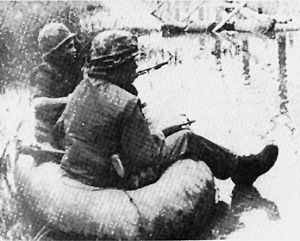Korean DMZ Conflict (1966–69)
| Korean DMZ Conflict | |||||||
|---|---|---|---|---|---|---|---|
| Part of the Korean Conflict | |||||||
 American and South Korean soldiers at the DMZ, on 26 August 1967. |
|||||||
|
|||||||
| Belligerents | |||||||
|
|
|
||||||
| Commanders and leaders | |||||||
|
|
|
||||||
| Casualties and losses | |||||||
|
South Korea: 299 killed 550 wounded United States: 43 killed 111 wounded |
397 killed 12 soldiers and 2,462 agents captured |
||||||
The Korean DMZ Conflict, also referred to as the Second Korean War by some, was a series of low-level armed clashes between North Korean forces and the forces of South Korea and the United States, largely occurring between 1966 and 1969 at the Korean DMZ; although other inter-Korean incidents occurred thereafter.
The Korean War had devastated both North and South Korea, and while neither side renounced its claims to reunify Korea under its control, neither side was in a position to force reunification.
In September 1956, Chairman of the Joint Chiefs of Staff Admiral Radford indicated within the U.S. government that the military's intention was to introduce atomic weapons into Korea, which was agreed to by the United States National Security Council and President Eisenhower. However paragraph 13(d) of the Korean Armistice Agreement mandated that both sides could not introduce new types of weapons into Korea, so preventing the introduction of nuclear weapons and missiles. The U.S. decided to unilaterally abrogate paragraph 13(d), breaking the Armistice Agreement, despite concerns by United Nations allies. At a 21 June 1957 meeting of the Military Armistice Commission, the U.S. informed the North Korean representatives that the U.N. Command no longer considered itself bound by paragraph 13(d) of the armistice. In January 1958, nuclear-armed Honest John missiles and 280mm atomic cannons were deployed to South Korea, followed a year later by nuclear-armed Matador cruise missiles capable of reaching China and the Soviet Union.
...
Wikipedia
